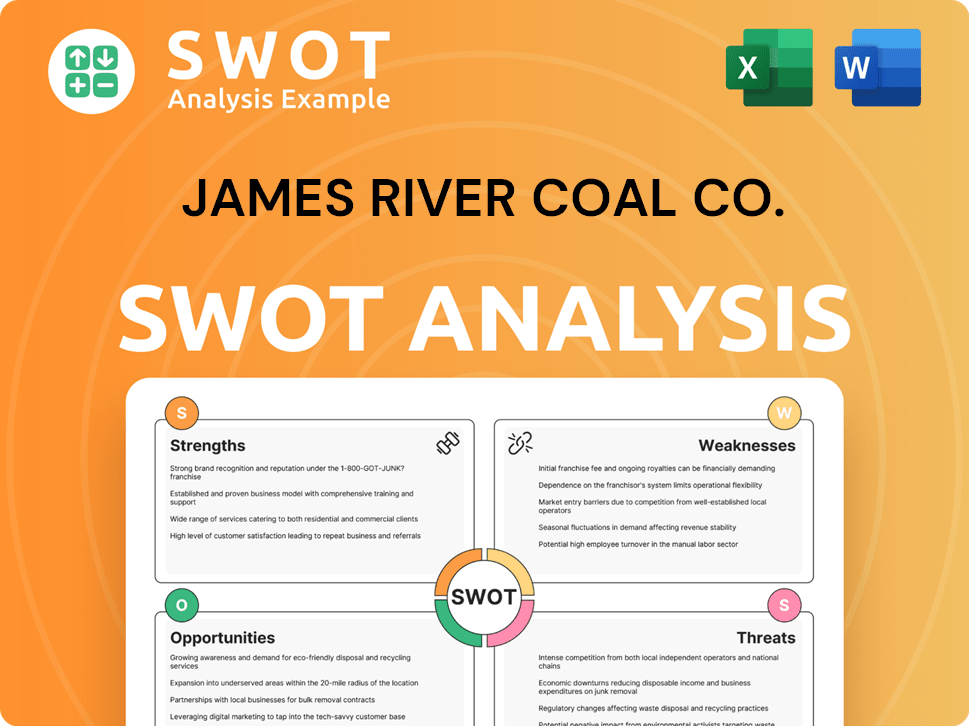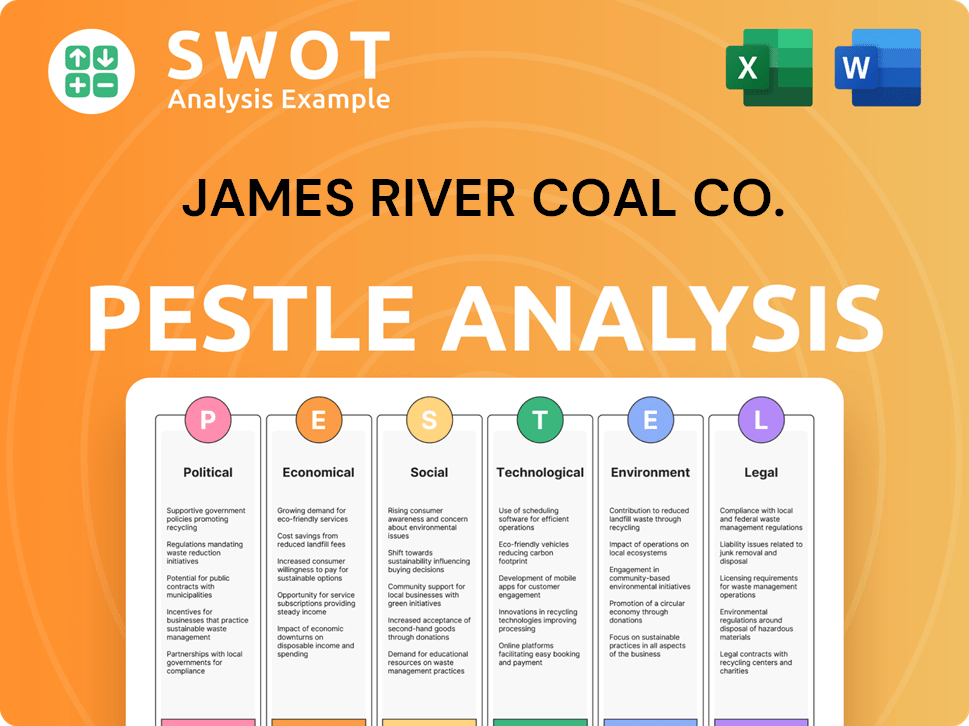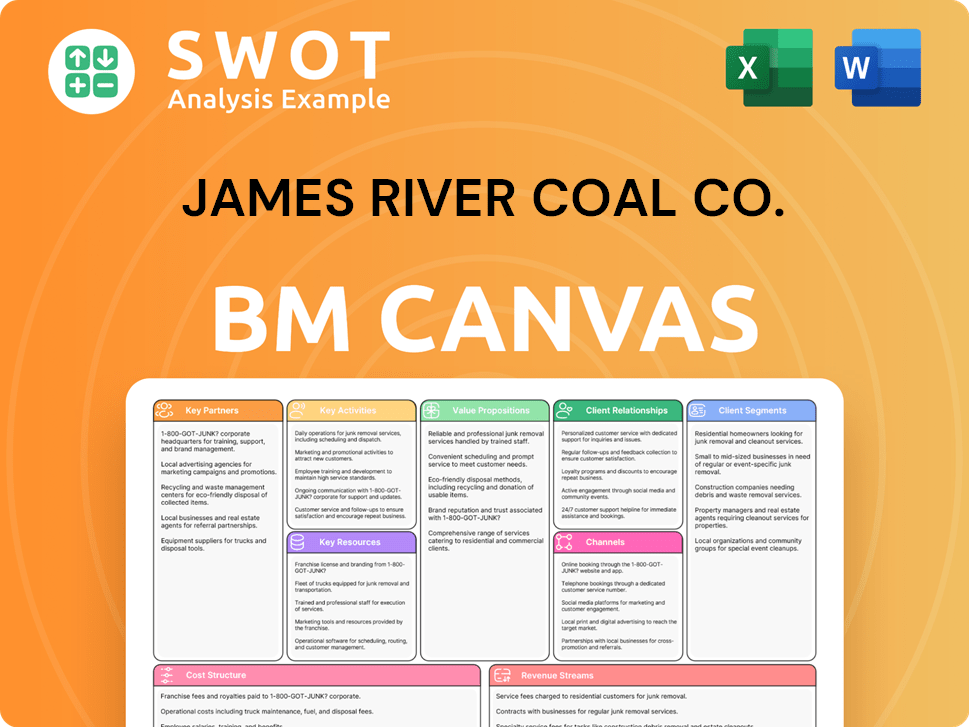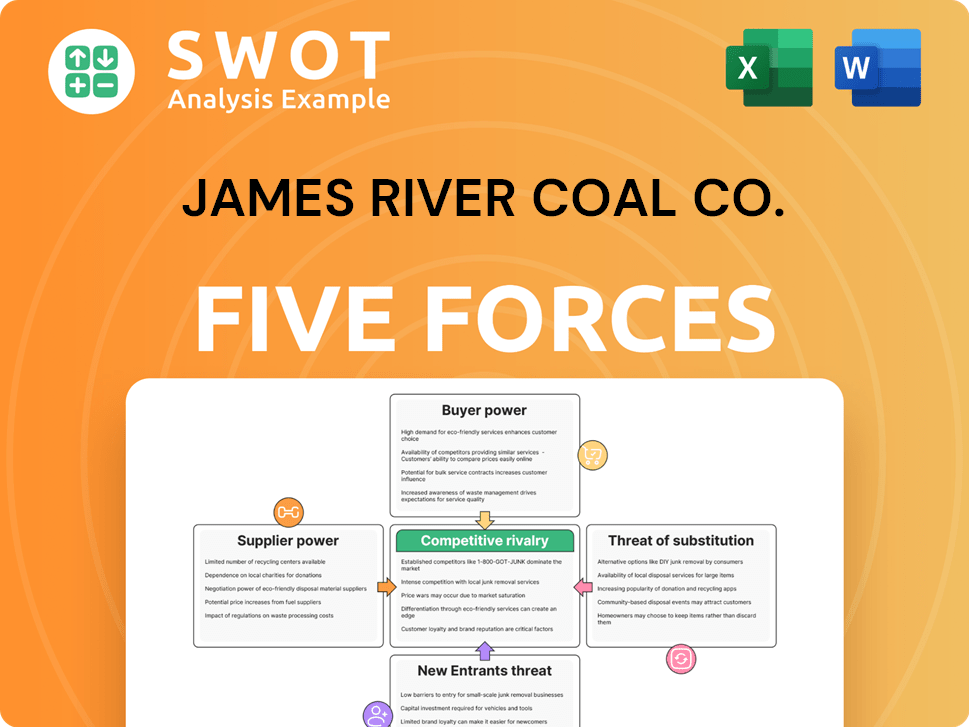James River Coal Co. Bundle
What Happened to James River Coal Co.?
Once a major player in the American energy sector, James River Coal Co. was a significant coal mining company that supplied crucial resources to power plants and steel mills. Its operations were deeply rooted in the coal production hubs of Central Appalachia and Illinois, regions that collectively produced millions of tons of coal annually. For investors and industry watchers, understanding the inner workings of James River Coal Co. is essential to grasping the dynamics of the coal industry.

The James River Coal Co. SWOT Analysis reveals the complex interplay of market forces that ultimately reshaped the company's destiny. This coal mining company's story is a compelling case study, illustrating the challenges faced by the energy sector, including shifts in demand, stringent environmental regulations, and competition from alternative energy sources. Examining James River Coal Co.'s history provides valuable insights into the broader trends impacting the coal industry and its future.
What Are the Key Operations Driving James River Coal Co.’s Success?
The core operations of James River Coal Co. centered on the extraction, processing, and sale of various types of coal. This coal mining company focused on bituminous, low-sulfur steam, and metallurgical coal. These products were then sold to different customer segments, including electric utility companies and steel mills.
James River Coal Co.'s operations involved both underground and surface mining methods. The company had a significant amount of coal reserves, with approximately 207 million tons of proven and probable reserves under its control as of March 31, 2004. This extensive reserve base supported its production capabilities and market position within the coal industry.
The company's value proposition was built on its ability to supply both steam and metallurgical coal. This diversified approach allowed it to cater to various market demands. In 2013, steam coal accounted for around 60% of its sales volume, while metallurgical coal made up the remaining 40%, showcasing the company's adaptability in the energy sector.
James River Coal Co. managed its mining operations through various subsidiaries, or mining complexes, located across eastern Kentucky, southern West Virginia, and southern Indiana. The company operated both 'Company' mines, using its own workforce, and also had rights to other mines operated by independent contract miners.
Throughout its history, James River Coal Co. expanded its operational capabilities and market reach through strategic acquisitions. These acquisitions added mines, preparation plants, and loadout facilities, enhancing its ability to meet customer demands. The company's presence in key coal basins, such as Central Appalachia and the Illinois Basin, was crucial for its coal production.
The supply chain for James River Coal Co. involved transporting coal from remote mining sites to processing facilities and then to customers. This process required complex logistics, including rail and port facilities, to ensure efficient delivery. The company's operations were significantly influenced by its ability to manage these logistics effectively.
- The company's operational success depended on its ability to efficiently extract and transport coal.
- James River Coal Co. had to navigate the challenges of transporting coal from mining sites to processing facilities.
- The logistics involved in the supply chain included rail and port facilities.
- The company's focus on both steam and metallurgical coal allowed it to serve diverse customer needs.
James River Coal Co. SWOT Analysis
- Complete SWOT Breakdown
- Fully Customizable
- Editable in Excel & Word
- Professional Formatting
- Investor-Ready Format

How Does James River Coal Co. Make Money?
The primary revenue streams for James River Coal Co., a coal mining company, historically revolved around the sale of steam coal and metallurgical coal. These two types of coal were the main drivers of the company's financial performance. The company's focus on these specific coal types highlights its position within the broader coal industry and its approach to mining operations.
Steam coal, primarily sold to electric utilities, historically accounted for a significant portion of the company's revenue, often representing around 90%. Metallurgical coal, used in steel production, also contributed substantially. Additionally, James River Coal Co. generated revenue from industrial coal sales and fees related to handling coal-based synfuel products, diversifying its income sources within the energy sector.
The company's monetization strategy heavily relied on long-term contracts with utilities for consistent revenue, particularly from steam coal. However, the expiration of these contracts and shifts in the market significantly impacted the company's financial health. Growth Strategy of James River Coal Co. provides further insights into the company's challenges.
In 2012, James River Coal Co. reported revenue of $1,099 million, followed by $1,177 million in 2011. By 2013, steam coal represented approximately 60% of the company's sales volume, with metallurgical coal accounting for the remaining 40%. The shift towards natural gas by utilities significantly impacted the demand and profitability of James River's coal sales.
- In 2013, the company sold approximately 4.2 million tons of coal to U.S. power plants.
- This represented a 30.1% decrease from the nearly 6 million tons sold in 2012.
- The company also faced lower prices for its coal in 2013.
- The reliance on major contracts and market shifts ultimately led to financial distress.
James River Coal Co. PESTLE Analysis
- Covers All 6 PESTLE Categories
- No Research Needed – Save Hours of Work
- Built by Experts, Trusted by Consultants
- Instant Download, Ready to Use
- 100% Editable, Fully Customizable

Which Strategic Decisions Have Shaped James River Coal Co.’s Business Model?
The story of James River Coal Co. began in 1988, marking its entry into the coal industry through acquisitions. Initially, the company focused on expanding its asset base and production capacity. Strategic moves included acquiring mines and preparation plants to increase its market presence and coal production.
Over the years, James River Coal Co. made several key acquisitions to grow its operations. These included Johns Creek Coal Company and the Bevins Branch Preparation Plant in 1992, followed by Leeco and Bledsoe in 1995. In 1998, the company acquired Blue Diamond, and in 1999, Shamrock Coal Company was added to its portfolio. These acquisitions were aimed at boosting coal production and market reach. In 2009, the company sold approximately 9.6 million tons of coal.
Despite these strategic expansions in the energy sector, James River Coal Co. faced significant challenges that ultimately led to its downfall. Declining demand for thermal coal, competition from natural gas, and increasing regulatory pressures eroded its competitive edge. The company's inability to adapt to these evolving market conditions resulted in its filing for Chapter 11 bankruptcy in April 2014.
Formed in 1988, James River Coal Co. quickly expanded through strategic acquisitions. The company acquired several mines and preparation plants to increase its coal production capacity. These moves aimed to strengthen its position within the coal mining company landscape.
The company's strategy involved acquiring key assets to boost its coal production. Acquisitions included Johns Creek Coal Company, Leeco, and Blue Diamond. In 2011, James River Coal Co. planned to purchase International Resource Partners LP for $475 million. These moves were designed to enhance market reach and production capabilities.
Initially, James River Coal Co. had a competitive edge through its presence in key coal basins and diversified production. The company produced both steam and metallurgical coal. However, market shifts, including the rise of natural gas and environmental regulations, eroded this advantage. The company's inability to adapt ultimately led to its bankruptcy.
James River Coal Co. filed for Chapter 11 bankruptcy on April 7, 2014, with over $800 million in debt. The company cited environmental regulations and market competition as key factors. Following the bankruptcy filing, the company sold its assets, including mining operations in West Virginia, Kentucky, and Indiana, by December 2014.
Several factors contributed to James River Coal Co.'s financial distress and eventual bankruptcy. The shift from coal to natural gas and renewable energy sources significantly reduced demand for thermal coal. Increasing regulatory pressures and a depressed metallurgical coal market further impacted the company's financial performance.
- Declining demand for thermal coal.
- Increased competition from natural gas.
- Rising environmental regulations.
- Depressed metallurgical coal market.
James River Coal Co. Business Model Canvas
- Complete 9-Block Business Model Canvas
- Effortlessly Communicate Your Business Strategy
- Investor-Ready BMC Format
- 100% Editable and Customizable
- Clear and Structured Layout

How Is James River Coal Co. Positioning Itself for Continued Success?
Prior to its bankruptcy, the James River Coal Co. was a notable player in the U.S. coal mining industry. The company focused on operations in Central Appalachia and the Illinois Basin. However, its market position was significantly affected by the overall decline in the coal industry, due to shifts in the energy landscape.
The U.S. coal industry has faced a steep decline over the years, with coal production dropping substantially. The share of coal in the U.S. electricity mix has also decreased considerably. This shift has created challenges for companies like James River Coal Co., impacting their financial performance and overall industry position.
The U.S. coal industry's decline has been ongoing, with production falling from 1 billion tons in 2014 to 578 million tons by 2023. Coal's share in the U.S. electricity mix has dropped from 50% two decades ago to about 16% in 2025. This decline has significantly impacted companies involved in coal production.
Key risks include stricter environmental regulations and competition from natural gas and renewables. The U.S. Energy Information Administration (EIA) forecasts a 7.2% drop in U.S. coal output in 2025. Although some expect a modest increase in coal-fired generation, it is likely to be met by existing inventories.
The global coal demand grew by 1.2% in 2024, driven by developing Asian economies. In 2025, global coal demand is expected to increase, mainly due to growth in China and India. The industry faces an uncertain future, balancing coal demand with the global shift towards renewable energy.
Renewables are poised to overtake coal as the leading power source globally in 2025. Metallurgical coal demand is projected to increase by USD 99.6 billion with a CAGR of 4.8% between 2024 and 2029. The EIA forecasts U.S. coal output to fall to 472.3 million short tons in 2025.
The coal industry faces challenges from regulatory changes and competition. Executive orders in April 2025 aimed at supporting U.S. coal production have uncertain long-term impacts. The industry must navigate the balance between sustained demand and the shift to renewable energy.
- Regulatory changes, such as stricter environmental regulations, continue to impact the coal industry.
- Competition from cheaper natural gas and growing renewable energy sources pose a challenge.
- The U.S. mining industry, including coal, faces an uncertain future due to increasing costs and competition.
- The rapid growth in utility-scale solar generation and coal-fired capacity retirements further reduce the market for coal.
James River Coal Co. Porter's Five Forces Analysis
- Covers All 5 Competitive Forces in Detail
- Structured for Consultants, Students, and Founders
- 100% Editable in Microsoft Word & Excel
- Instant Digital Download – Use Immediately
- Compatible with Mac & PC – Fully Unlocked

Related Blogs
- What are Mission Vision & Core Values of James River Coal Co. Company?
- What is Competitive Landscape of James River Coal Co. Company?
- What is Growth Strategy and Future Prospects of James River Coal Co. Company?
- What is Sales and Marketing Strategy of James River Coal Co. Company?
- What is Brief History of James River Coal Co. Company?
- Who Owns James River Coal Co. Company?
- What is Customer Demographics and Target Market of James River Coal Co. Company?
Disclaimer
All information, articles, and product details provided on this website are for general informational and educational purposes only. We do not claim any ownership over, nor do we intend to infringe upon, any trademarks, copyrights, logos, brand names, or other intellectual property mentioned or depicted on this site. Such intellectual property remains the property of its respective owners, and any references here are made solely for identification or informational purposes, without implying any affiliation, endorsement, or partnership.
We make no representations or warranties, express or implied, regarding the accuracy, completeness, or suitability of any content or products presented. Nothing on this website should be construed as legal, tax, investment, financial, medical, or other professional advice. In addition, no part of this site—including articles or product references—constitutes a solicitation, recommendation, endorsement, advertisement, or offer to buy or sell any securities, franchises, or other financial instruments, particularly in jurisdictions where such activity would be unlawful.
All content is of a general nature and may not address the specific circumstances of any individual or entity. It is not a substitute for professional advice or services. Any actions you take based on the information provided here are strictly at your own risk. You accept full responsibility for any decisions or outcomes arising from your use of this website and agree to release us from any liability in connection with your use of, or reliance upon, the content or products found herein.